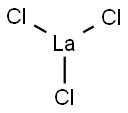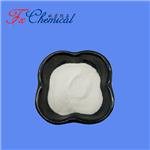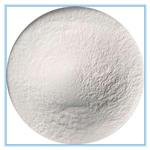Physical Properties
The anhydrous chloride is a white hexagonal crystal; hygroscopic; density 3.84 g/cm3; melts at 850°C; soluble in water. The heptahydrate is a white triclinic crystal; decomposes at 91°C; soluble in water and ethanol.
Uses
Lanthanum(III) chloride is used to prepare other lanthanum salts. The anhydrous chloride is employed to produce lanthanum metal.
Structure
Lanthanum(III) chloride (LaCl3) crystal has a UCl3 type structure, space group P63/m, and it has attracted much attention for its high light output and good energy resolution. LaCl3 crystal belongs to a hexagonal system; its density is 3.8g/cm3. Its energy resolution is 3.1%, and its decay time Is 26 ns and a time resolution of 224 ps. There is almost no damage after exposure to gamma rays up to 3 kGy. Such excellent scintillation performance is very rare in inorganic compounds. The energy is 60 keV to 1275 keV. Under the excitation of γ-ray source, the nonlinear response coefficient of light output is 7%, which is far superior to LSO: Ce crystal (35%), NaI: Tl crystal (15%) and CsI: Tl (20%). Based on its excellent numbers, this scintillation material can find its place in such applications as medical imaging, nuclear physics, X-ray diffraction, non-destructive evaluation, treaty verification and safeguards, environmental monitoring, and geological exploration.
Preparation
Lanthanum(III) chloride is formed by dissolving the oxide, hydroxide or carbonate in hydrochloric acid, followed by crystallization. The anhydrous chloride is obtained by heating oxide, hydroxide, or carbonate in an atmosphere of dry hydrogen chloride.
La2(CO3)3 + 6HCl → 2LnCl3 + 3CO2 + 3H2O
Another method involves heating lanthanum oxide with excess ammonium chloride at 300°C.
Reactions
When heated in the presence of water vapor, lanthanum oxochloride is formed:
LaCl3 + H2O→LaOCl + 2HCl
Heating with glass at elevated temperatures also forms oxochloride:
LaCl3 + SiO2→2LaOCl + SiCl4
Lanthanum chloride reacts with hydrogen sulfide when heated at 1100°C, forming lanthanum sulfide:
2LaCl3 + 3H2S→La2S3 + 3H2S
Reactions with ammonia and phosphine at elevated temperatures yield lanthanum nitride and phosphide, respectively:
LaCl3 + PH3→LaP + 3HCl
Lanthanum chloride is reduced to lanthanum metal when heated with an alkali or alkaline earth metal at temperatures above 1000°C:
LaCl3 + 3Li→La + 3LiCl
Description
Lanthanum(III) chloride is a relatively stable non-homogeneous catalyst widely used in a variety of organic reactions or transformations. These include the solvent-free preparation of substituted olefins via the Knoevenagel condensation method; the one-pot synthesis of 3,4-dihydropyrimidin-2(1H)-ones; and as a precursor for the synthesis of La/V co-doped TiO2 nanoparticles via the sol-gel method.
Chemical Properties
Lanthanum(III) chloride is white powder or colourless crystals
Uses
Lanthanum chloride is a precursor for synthesis of lanthanum phosphate nano rods and used in gamma detectors. It is also used as a catalyst for high pressure oxidative chlorination of methane to chloromethane with hydrochloric acid and oxygen. In organic synthesis, lanthanum trichloride acts as lewis acid for the conversion of aldehydes to acetals.
Uses
Lanthanum chloride is used to prepare other lanthanum salts. The anhydrous chloride is employed to produce lanthanum metal.
Preparation
The heptahydrate is formed by dissolving the oxide, hydroxide or carbonate in hydrochloric acid, followed by crystallization. The anhydrous chloride is obtained by heating oxide, hydroxide, or carbonate in an atmosphere of dry hydrogen chloride.
La
2(CO
3)
3 + 6HCl → 2LnCl
3 + 3CO
2 + 3H
2O
Another method involves heating lanthanum oxide with excess ammonium chloride at 300°C.
General Description
Lanthanum(III) chloride is white crystalline solid. Gives an amber aqueous solution that can cause destruction or irreversible alterations in human skin tissue at the site of contact. Has a severe corrosion rate on steel.
Air & Water Reactions
Deliquescent. Water soluble.
Reactivity Profile
Aqueous solutions of LANTHANUM CHLORIDE contain moderate concentrations of hydrogen ions and react as acids to neutralize bases. Does not usually react as either oxidizing agents or reducing agents but such behavior is not impossible. May catalyze organic reactions.
Health Hazard
TOXIC; inhalation, ingestion or skin contact with material may cause severe injury or death. Contact with molten substance may cause severe burns to skin and eyes. Avoid any skin contact. Effects of contact or inhalation may be delayed. Fire may produce irritating, corrosive and/or toxic gases. Runoff from fire control or dilution water may be corrosive and/or toxic and cause pollution.
Fire Hazard
Non-combustible, substance itself does not burn but may decompose upon heating to produce corrosive and/or toxic fumes. Some are oxidizers and may ignite combustibles (wood, paper, oil, clothing, etc.). Contact with metals may evolve flammable hydrogen gas. Containers may explode when heated.
reaction suitability
reagent type: catalyst
core: lanthanum






